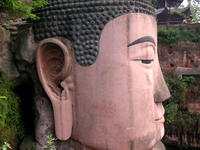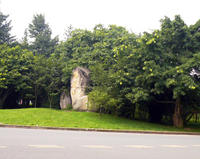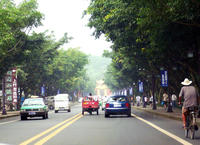You are in: Asia -> China -> Mount Emei Scenic Ar... , and traditional search or Image Gallery will yield results of this site only
Mount Emei Scenic Area, including Leshan Giant Buddha Scenic Area
| Site number: | 779 |
|
| Type of site: | Mixed | |
| Date: | 1st c. | |
| Date of Inscription: | 1996 | |
| Location: | Asia, China, Sichuan Province, Eimeishan City | |
Up to 75 images are shown here. Click on each for more details or on Image Gallery for more images.
| Description: | The Sichuan Province, and within it the beautiful surroundings of the summit of Mount Emei, saw the construction of the country’s first Buddhist temple built here in the 1st century A.D. The site became one of Buddhism's holiest locations as the temple experienced the addition of other temples. Over the centuries, the number of cultural treasures grew; the most noteworthy is the 8th century Giant Buddha of Leshan, carved out of a hillside facing down upon the meeting of three rivers. With a height of 71 m, it is the world’s largest Buddha. Mount Emei houses exceptionally diverse vegetation, varying from subtropical to subalpine pine forests, boasting a number of 1,000 year old trees. --WHMNet paraphrase from the description at WHC Site, where additional information is available. For 360 degree imaging of this site, click here. | |
| The Leshan Giant Buddha (simplified Chinese: 乐山大佛; traditional Chinese: 樂山大佛; pinyin: Lèshān Dàfó) is the tallest stone Buddha statue in the world, built during the Tang Dynasty (618-907). It is carved out of a cliff face that lies at the confluence of the Minjiang, Dadu and Qingyi rivers in the southern part of Sichuan province in China, near the city of Leshan. The stone sculpture faces Mount Emei, with the rivers flowing below his feet. The Mount Emei Scenic Area, including Leshan Giant Buddha Scenic Area has been listed as a UNESCO World Heritage Site since 1996. Like many of China's other UN designated World Heritage sites, the Leshan Buddha has fallen victim to the pollution emanating from the unbridled development in the region. The culprit has been determined to be the growing number of coal fired power plants located near the Giant Buddha, primarily the toxic gases that their smokestacks spew into the air which eventually return to the earth as acid rain. Over time, the Buddha's nose has turned black and the curls of his hair began to fall from his head. Construction was started in 713 AD, led by a Chinese monk named Haitong. He hoped that the Buddha would calm the turbulent waters that plagued the shipping vessels travelling down the river. When funding for the project was threatened, he is said to have gouged out his own eyes to show his piety and sincerity. Construction was completed by his disciples ninety years later. Apparently the massive construction resulted in so much stone being removed from the cliff face and deposited into the river below that the currents were indeed altered by the statue, making the waters safe for passing ships. --Wikipedia. Text is available under the Creative Commons Attribution-ShareAlike License. For 360 degree imaging of this site, click here. | ||
| Source: | http://whc.unesco.org/en/list/779 | |
| Reference: | 1. UNESCO World Heritage Center, Site Page. | |












































































